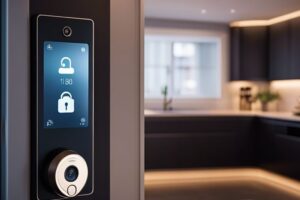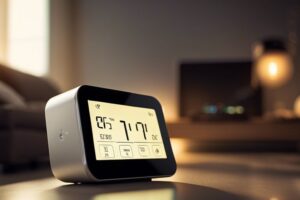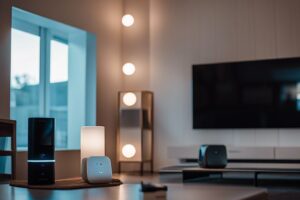As you age or face physical challenges, everyday tasks can become difficult and sometimes dangerous. Smart home gadgets offer a range of benefits that can greatly improve your quality of life. These devices can enhance independence, safety, and convenience for elderly or disabled individuals. According to a study published in the National Library of Medicine, smart home technologies can help older adults manage their health and well-being more effectively. You can learn more about this study here. From voice-activated assistants to home monitoring systems, smart gadgets can empower you to live more comfortably and securely in your own home. In this blog post, we will explore the various ways in which smart home gadgets can benefit you as you navigate the challenges of ageing or physical disabilities.
Key Takeaways:
- Independence: Smart home gadgets can provide elderly or disabled individuals with the ability to perform daily tasks independently, such as turning on lights, adjusting temperatures, or locking doors.
- Safety: These gadgets can enhance the safety of vulnerable individuals by monitoring their movements, detecting falls, and sending alerts to caregivers or emergency services when needed.
- Convenience: Smart home gadgets can make routine activities more convenient for elderly or disabled individuals by automating repetitive tasks and allowing for remote control of appliances and devices.
- Social connectedness: These gadgets can help alleviate feelings of loneliness and isolation by enabling easier communication with family and friends through video calls or voice commands.
- Health monitoring: Some smart home gadgets can track health data, remind individuals to take medication, and even provide virtual consultations with healthcare professionals, promoting better overall well-being.
Enhancing Safety and Security
When it comes to smart home gadgets, one of the most significant benefits for elderly or disabled individuals is the enhancement of safety and security within the home. From fall detection and alert systems to automated locks and security cameras, these devices provide peace of mind for both the individual and their loved ones.
Fall Detection and Alert Systems
For elderly or disabled individuals, the risk of falling and injuring themselves is a significant concern. Smart home gadgets can offer a solution in the form of fall detection and alert systems. These devices are designed to detect when a fall has occurred and automatically alert a designated caregiver or emergency services. This quick response can be crucial in preventing serious injury or even saving a life.
Automated Locks and Security Cameras
Automated locks and security cameras provide added protection for elderly or disabled individuals within their homes. With automated locks, you have the convenience of being able to control who has access to your home, providing a strong deterrent against potential intruders. Meanwhile, security cameras allow you to monitor activity in and around your home, providing an added sense of security and the ability to quickly identify any potential threats or issues.
Promoting Independence
One of the key benefits of smart home gadgets for elderly or disabled individuals is the ability to promote independence. By providing these individuals with the tools and technology they need to control their environment, you are enabling them to maintain their autonomy and make decisions for themselves.
Voice-Activated Assistants and Controls
Voice-activated assistants and controls, such as smart speakers and voice-activated remote controls, can be incredibly helpful for individuals with limited mobility or dexterity. With the simple use of your voice, you can control various aspects of your home, such as adjusting the thermostat, turning lights on and off, or even locking doors. This not only saves you the physical effort of performing these tasks but also gives you a sense of empowerment and control over your surroundings.
Adaptive Appliances and Tools
Adaptive appliances and tools, including smart kitchen appliances and automated medication dispensers, can make daily tasks much more manageable for elderly or disabled individuals. These devices are designed to assist you in completing tasks that may otherwise be challenging, such as cooking a meal or remembering to take medication. By incorporating these adaptive tools into your home, you can maintain a higher level of independence and reduce the need for constant assistance.
By leveraging the capabilities of these voice-activated assistants and controls and adaptive appliances and tools, you can significantly enhance your ability to manage daily activities and maintain your independence within your home.
Health Monitoring and Management
Health monitoring and management are crucial for elderly or disabled individuals to maintain their well-being. Smart home gadgets offer a range of solutions to help in this area, providing tools for remote health monitoring and medication management to ensure that health needs are met effectively.
Remote Health Monitoring Devices
Remote health monitoring devices allow you to keep track of vital signs and health data without the need for constant trips to the doctor’s office. These devices can measure your blood pressure, heart rate, blood glucose levels, and even monitor your sleep patterns. They can provide early warning signs of potential health issues, allowing for early intervention and prevention. This can be especially important for individuals with chronic conditions such as diabetes, hypertension, or heart disease, as well as for those recovering from an illness or surgery.
Medication Management Tools
Medication management tools help you to keep track of your medication schedule, ensuring that you never miss a dose. These gadgets can dispense the correct pills at the right time, send reminders to your smartphone, and even alert your caregivers or healthcare providers in case of a missed dose or potential issue. This is crucial for individuals who have complex medication regimens or memory issues, helping to prevent medication errors and ensuring that you stay on top of your treatment plan.
Social Connection and Entertainment
Smart home gadgets can significantly benefit elderly or disabled individuals by enhancing their social connections and providing entertainment options. These devices offer a range of functionalities that can help you stay connected with loved ones and access various forms of entertainment from the comfort of your home.
Video Communication Devices
Video communication devices, such as smart displays and video calling systems, enable you to easily connect with family and friends, regardless of physical distance. These gadgets allow you to have face-to-face conversations and share experiences in real-time, helping you combat feelings of loneliness and isolation. Additionally, some video communication devices are equipped with voice-activated technology, making it easier for you to initiate calls and navigate the interface.
Smart Entertainment Systems
Smart entertainment systems, including voice-controlled smart speakers and streaming devices, offer a wide range of entertainment options at your fingertips. With these devices, you can access music, audiobooks, podcasts, and even control your television with simple voice commands. They also provide access to a variety of educational and informative content, allowing you to stay engaged and entertained while expanding your knowledge in the comfort of your home.
Summing up
Smart home gadgets can greatly benefit elderly or disabled individuals by providing them with increased independence, safety, and convenience. With the help of these devices, you can automate everyday tasks, control your home environment with voice commands, and receive timely alerts in case of emergencies. Additionally, smart home technology can assist in monitoring your health and well-being, allowing you to stay connected and supported even when living alone. Overall, incorporating smart home gadgets into your living space can greatly enhance your quality of life and provide peace of mind for you and your loved ones.
FAQ
Q: How can smart home gadgets benefit elderly or disabled individuals?
A: Smart home gadgets can benefit elderly or disabled individuals by providing increased safety, security, convenience, and independence.
Q: What are some examples of smart home gadgets that can benefit elderly or disabled individuals?
A: Examples of smart home gadgets include smart door locks, motion-sensor lights, video doorbells, smart thermostats, and voice-activated assistants such as Amazon Echo or Google Home.
Q: How do smart door locks benefit elderly or disabled individuals?
A: Smart door locks can benefit elderly or disabled individuals by allowing them to lock and unlock doors remotely, without the need for physical keys. This provides convenience and reduces the risk of lost keys.
Q: In what ways can motion-sensor lights benefit elderly or disabled individuals?
A: Motion-sensor lights can benefit elderly or disabled individuals by automatically illuminating their path, reducing the risk of falls and providing added security when movement is detected.
Q: What advantages do video doorbells offer for elderly or disabled individuals?
A: Video doorbells allow elderly or disabled individuals to see and communicate with visitors from their smartphone or tablet, providing an added layer of security and convenience.
Q: How can smart thermostats benefit elderly or disabled individuals?
A: Smart thermostats can benefit elderly or disabled individuals by allowing them to control the temperature of their home remotely and set schedules for heating and cooling, providing comfort and energy savings.
Q: What role do voice-activated assistants play in benefiting elderly or disabled individuals?
A: Voice-activated assistants such as Amazon Echo or Google Home can benefit elderly or disabled individuals by allowing them to control smart home devices, set reminders, listen to music, and access information using voice commands, reducing the need for physical interaction with devices.







